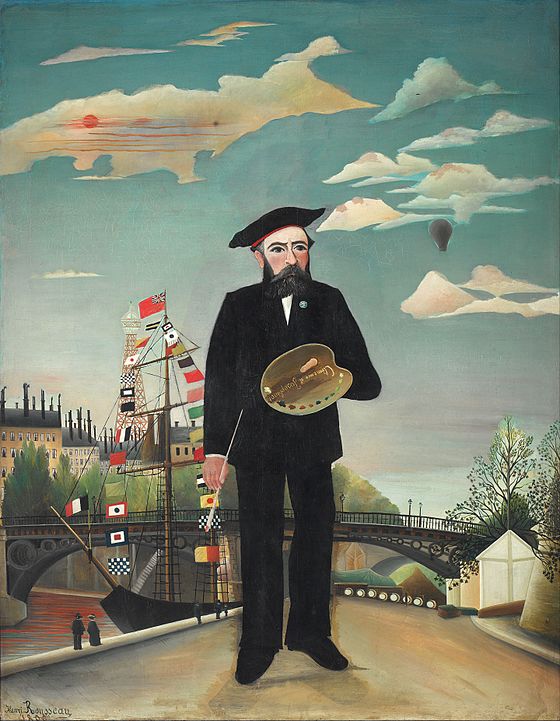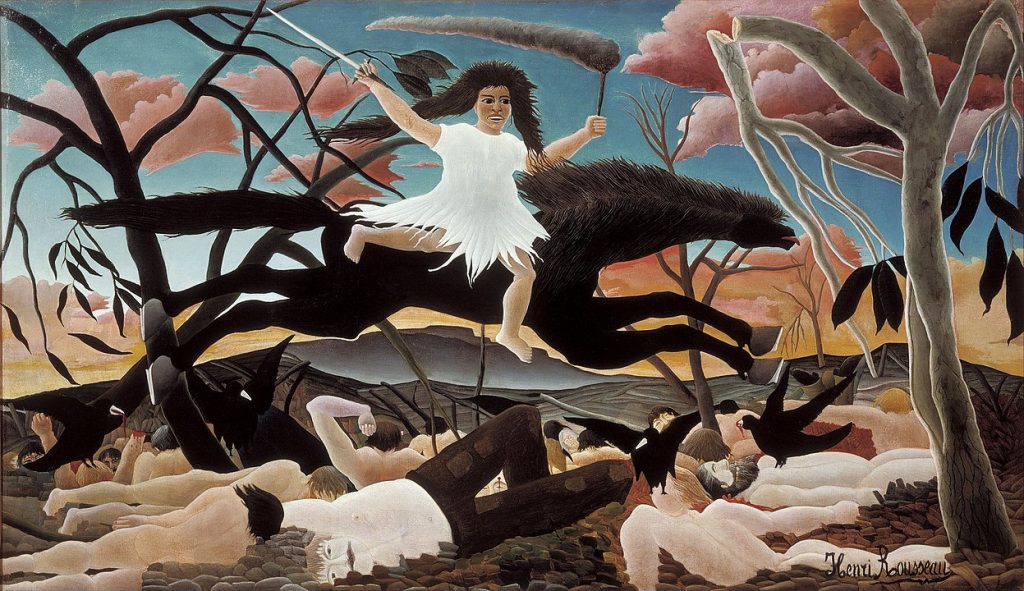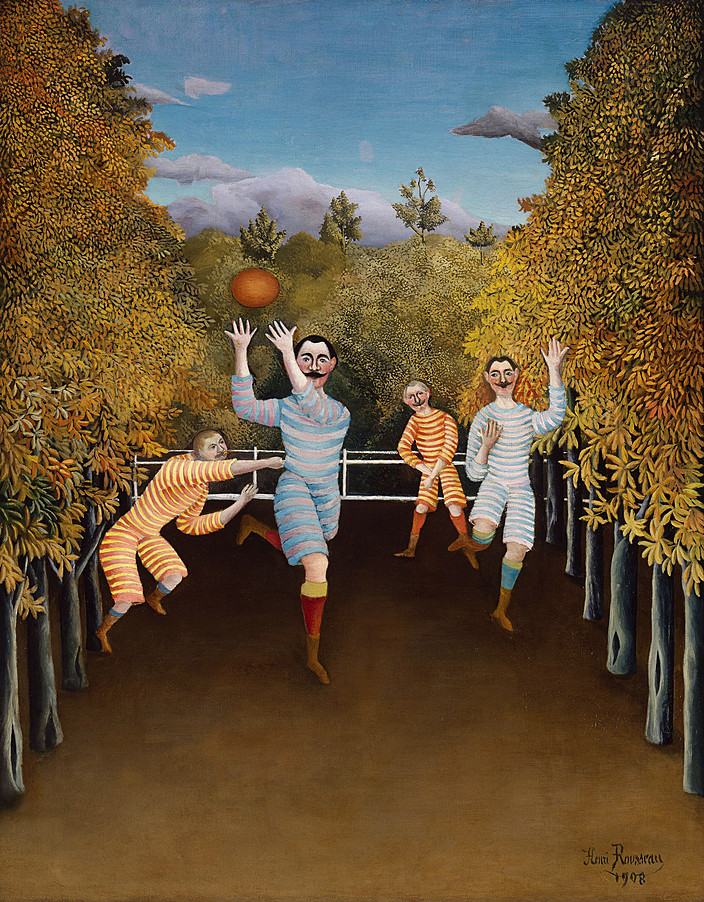Who was Henri Rousseau

Henri Rousseau
, National Gallery PragueHenri Rousseau (1844 – 1910) was a French post-impressionist painter in the Naïve or Primitive manner. He was also known as Le Douanier (the customs officer), a humorous description of his occupation as a toll and tax collector. He started painting seriously in his early forties; by age 49, he retired from his job to work on his art full-time. Ridiculed during his lifetime by critics, he came to be recognized as a self-taught genius whose works are of high artistic quality. Rousseau claimed he had “no teacher other than nature”, and his work exerted an extensive influence on several generations of avant-garde artists.
His best-known paintings depict jungle scenes, even though he never left France or saw a jungle. Stories spread by admirers that his army service included the French expeditionary force to Mexico are unfounded. During his army service, he met soldiers who had survived the French expedition to Mexico, and he listened to their stories of the subtropical country they had experienced. His inspiration came from illustrations in children’s books and the botanical gardens in Paris, as well as tableaux of taxidermy wild animals. To the critic Arsène Alexandre, he described his frequent visits to the Jardin des Plantes: “When I go into the glass houses and I see the strange plants of exotic lands, it seems to me that I enter into a dream.”

Along with his exotic scenes there was a concurrent output of smaller topographical images of the city and its suburbs. He claimed to have invented a new genre of portrait landscape, which he achieved by starting a painting with a specific view, such as a favourite part of the city, and then depicting a person in the foreground.
EARLY LIFE
Rousseau’s father was a tinsmith; Henri was forced to work with him as a small boy. Eventually his father became a debtor and his parents had to leave the town upon the seizure of their house. Though mediocre in some of his high school subjects, Rousseau won prizes for drawing and music.
After high school, he worked for a lawyer and studied law, but “attempted a small perjury and sought refuge in the army.” After his father’s death, Rousseau moved to Paris in 1868 to support his widowed mother as a government employee.
Also in 1868, he married Clémence Boitard, his landlord’s 15-year-old daughter, with whom he had six children (only one survived). In 1871, he was appointed as a collector of taxes on goods entering Paris. His wife died in 1888 and he married Josephine Noury in 1898.
In 1893, Rousseau moved to a studio in Montparnasse where he lived and worked until his death in 1910. In 1897, he produced one of his most famous paintings, La Bohémienne endormie (The Sleeping Gypsy).
CAREER
From 1886, he exhibited regularly in the Salon des Indépendants, and, although his work was not placed prominently, it drew an increasing following over the years. Tiger in a Tropical Storm (Surprised!) was exhibited in 1891, and Rousseau received his first serious review when the young artist Félix Vallotton wrote: “His tiger surprising its prey ought not to be missed; it’s the alpha and omega of painting.” Yet it was more than a decade before Rousseau returned to painting the jungle scenes for which he is best known.

Henri Rousseau
, National Gallery, LondonIn 1905, Rousseau’s large jungle scene The Hungry Lion Throws Itself on the Antelope was exhibited at the Salon des Indépendants near works by younger leading avant-garde artists such as Henri Matisse, in what is now seen as the first showing of The Fauves. Rousseau’s painting may even have influenced the naming of the Fauves
When Pablo Picasso happened upon a painting by Rousseau being sold on the street as a canvas to be painted over, the younger artist instantly recognised Rousseau’s genius and went to meet him. In 1908, Picasso held a half serious, half burlesque banquet in his studio at Le Bateau-Lavoir in Rousseau’s honour. Le Banquet Rousseau, “one of the most notable social events of the twentieth century,” wrote American poet and literary critic John Malcolm Brinnin, “was neither an orgiastic occasion nor even an opulent one. Its subsequent fame grew from the fact that it was a colorful happening within a revolutionary art movement at a point of that movement’s earliest success, and from the fact that it was attended by individuals whose separate influences radiated like spokes of creative light across the art world for generations.” Picasso’s later work “Guernica” was heavily influenced by Rousseau’s “La Guerre”

Guests at the banquet Rousseau included: Guillaume Apollinaire, Jean Metzinger, Juan Gris, Max Jacob, Marie Laurencin, André Salmon, Maurice Raynal, Daniel-Henri Kahnweiler, Leo Stein, and Gertrude Stein.
André Salmon recalled the setting of the illustrious banquet
“Here the nights of the Blue Period passed… here the days of the Rose Period flowered… here the Demoiselles d’Avignon halted in their dance to re-group themselves in accordance with the golden number and the secret of the fourth dimension… here fraternized the poets elevated by serious criticism into the School of the Rue Ravignan… here in these shadowy corridors lived the true worshippers of fire … here one evening in the year 1908 unrolled the pageantry of the first and last banquet offered by his admirers to the painter Henri Rousseau called the Douanier.”
RETIREMENT AND DEATH
After Rousseau’s retirement in 1893, he supplemented his small pension with part-time jobs and work such as playing a violin in the streets. He also worked briefly at Le petit Journal, where he produced a number of its covers. Rousseau exhibited his final painting, The Dream, in March 1910, at the Salon des Independants. In the same month Rousseau suffered from a leg ulcer which became gangrinous. After an operation, he died from a blood clot on 2 September 1910.




